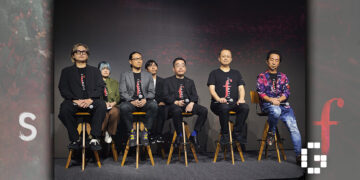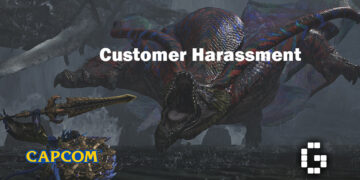It was a blast throughout the weekend experiencing all sorts of tabletop games at this year’s TableCon Quest, not just from big publishers but also from plenty of indie developers.
If you are itching to try out some new and fresh board games, we had the opportunity to check out some from indie developers at TableCon Quest – they are full of interesting ideas. We have tried quite a few of them, but here are the 3 that we would love to highlight – Spirit War, Kabuki Tricks, and Legions of Kadmon.

Spirit War
Starting with Spirit War first, this is a card game from Boardverse with a straightforward concept and rule – very much like rock, paper, and scissors, but with elementals, namely fire, water, and earth. This game is all about luck and mind games and can be played by 2 to 5 people.

Starting the game, we draw out 5 cards. There are no hand limits, but whoever runs out of cards and takes the last hit will lose. The cards are split into spirit cards as monsters and spells, which dictate magic and buffs. Hearing that you might believe you need to have experience with trading card games to play, but in reality, it is a simple game to catch up with.
In the middle field, there are 2 stacks of cards – preparation and encounter cards. Every turn, players can draw one card from the preparation pile to restock cards on hand, then draw an encounter card. Encounter cards are varied, such as drawing extra cards or attack cards. Spirit War is best recommended to be played with a larger group of people because encounter cards can trigger battles in unexpected ways, such as forcing a player opposite of you or by your left or right side to a duel.
Once an attack card is drawn, the player will enter the Attack Phase, which is made up of 2 phases. In the first phase, players will summon a spirit card and see if their spirit is getting restricted or not based on elements – water restricts fire, fire restricts earth, and earth restricts water. Then, in phase 2, we can play our support, which can be either spirits or spells. Whether you play any support is up to you. There are many spells you can work with, such as one when you lose you return your summoned card to hand, one that changes the element of the spirit into another, or another that swaps spirit.

You can even use the spirit of the same element as support, transforming it into the restricting element – water plus water equals earth. Whoever wins in battle can keep the spirits and the spells used will be discarded. Whoever loses, two cards will be discarded. If it is a draw, both players will discard their cards. Whoever stays until the end will be crowned the winner, it is as simple as that, but extremely fun.
To purchase or learn more about Spirit War, you can refer to the links below:
Kabuki Tricks
The next game is Kabuki Tricks by Good Spirit Games, which has players assume the roles of producers for Kabuki performances – where the quality of showmanship depends on the number of tricks to be won.

Kabuki Tricks is played over several rounds and each player will have a chance to play as a dealer – taking on the responsibility to shuffle the suit deck each round to distribute 7 suit cards face-down, then deciding on the trumps by arranging the high-low card and actor cards. Arranging the actor cards from left to right means what patterns will be the strongest would be the high-low card – that means in the whole turn, either 1 will be the strongest or 9 will be the strongest.
There are 4 patterns of cards in the game – sakura as pink, music as green, tea cup as yellow, and fan as blue. Every player will get a joker card and a tricks card at the start. Every turn the dealer can choose to put a suit card, and then other players need to follow the pattern to put their suit cards. If they don’t have any same pattern cards, players can put other pattern cards. Whoever has the higher number or higher pattern wins the turn, then collects all the suit cards in the field and takes 1 trick a 1 point. Besides that, players can use the Joker card, but not as the last card. The first player giving out the suit card is not allowed either. Joker cards can be used to put in your trick card to guess which pattern will be your last card and how many tricks will have on the last round, if guessed correctly you will get extra points.
After placing their trick cards, players can either choose to arrange the high-low cards or the actor cards. Overall, the game is a fun time, and rather easy to catch up, but it does take some time before understanding the best time to bring out the Joker card, as well as knowing how to stack the tricks to be higher. The Japanese traditional culture inspiration is also a plus.
To purchase or learn more about Kabuki Tricks, you can refer to the links below:
Legions of Kadmon
Lastly, we have Legions of Kadmon, a more traditional board game with a dark fantasy setting. For this game, the developers recommend players help each other more than go against each other’s throats. Playtime can go from 30 minutes to 2 hours.

At the start, every player acts as a necromancer, summing creatures to fight for them. In each turn, players can do three actions – Summoning, Spell-Casting, and Invoking. To summon, a player places one card from their hand into their Vassal Zone. Once the card enters the Vassal Zone, they are considered a Unit and is referred to as a Player’s Vassal. A summoned Unit will deal and endure damage during Combat.
The combat phase can get a little confusing and will involve maths! During the Combat Phase, the units in each Player’s Zones will ‘fight’ each other. The Player’s Vassal will deal damage to that player’s Legion and vice versa. Players will have the liberty to assign combat damage however they please. Units do not deal damage to individual units, rather, the entire Combat Phase can be re-imagined as a huge brawl. Damage to be distributed to each faction is represented by the total Power the opposing faction has. Kill a unit to get cards – in most of the card games, when you kill a unit, it will simply go to the graveyard but in this game, it will go into your hand. When a player deals damage to the Active Legendary Unit – the card in the middle that acts as a boss, that player collects Kadmon’s Ichor from it according to the damage dealt.

Combat Damage can only be dealt to the Active Legendary Unit only if all damage has been assigned to that Player’s Legion. When an Active Legendary Unit runs out of Kadmon’s Ichor, it is then destroyed. The Player that dealt the final blow can put that Legendary Unit to their hand just like any other Unit. After that, a new Legendary Unit is revealed by flipping the next card on top of the Crown. This process repeats until Kadmon is defeated.
The winner of the game is the player that collected the most Ichor throughout the game. So far, Legions of Kadmon is looking very promising with its lovingly illustrated art and worldview, filled with dark fantasy monsters and deep-established lore to dive into.
To learn more about Legions of Kadmon, you can refer to the links below:
These are only 3 out of many wonderful indie board games we got to experience here at TableCon Quest. It was certainly fun hearing fans gush about their love for board games and developers sharing their thoughts when developing board games.
If you are into tabletop gaming, be sure to check out the TableCon Quest convention when it returns next year – confirmed in an interview we had with Elicia Lee, Managing Director of Eliphant, and co-organizer of TableCon Quest alongside Genesis Frontier.

![[EXCLUSIVE] Resident Evil Survival Unit Executive Producer Shinji Hashimoto Opens Up About Resident Evil’s Mobile Evolution](https://cdn.gamerbraves.com/2025/08/Resident-Evil-Survival-Unit_Interview_FI-360x180.jpg)

![[gamescom2025] Onimusha: Way of the Sword Preview – Musashi Strikes Back in Demon-Infested Kyoto](https://cdn.gamerbraves.com/2025/08/Onimusha-Hands-On-Preview_Preview_FI-360x180.jpg)






![[BIC2025] Exclusive Interview with Tripearl Games CEO on Adapting The Player Who Can’t Level Up for Gaming](https://cdn.gamerbraves.com/2025/08/BIC-2025-Player-Who-Cant-Level-Up_Interview_FI-360x180.jpg)


![[EXCLUSIVE] Honor of Kings Goes Global: Interview with James Yang on International Esports Expansion](https://cdn.gamerbraves.com/2025/08/James-Yang-Exclusive_Interview_FI-360x180.jpg)


![[ TableCon Quest 2024 ] Checking Out Indie Board Games Spirit War, Kabuki Tricks, and Legions of Kadmon](https://cdn.gamerbraves.com/2024/06/GamerBraves-Featured-Image-TableCon-Quest-2024-Indie-Tabletop-Board-Card-Game-Games-Kabuki-Tricks-Spirit-War-Legions-of-Kadmon-750x392.jpg)
![[EXCLUSIVE] Resident Evil Survival Unit Executive Producer Shinji Hashimoto Opens Up About Resident Evil’s Mobile Evolution](https://cdn.gamerbraves.com/2025/08/Resident-Evil-Survival-Unit_Interview_FI-350x250.jpg)

![[gamescom2025] Onimusha: Way of the Sword Preview – Musashi Strikes Back in Demon-Infested Kyoto](https://cdn.gamerbraves.com/2025/08/Onimusha-Hands-On-Preview_Preview_FI-350x250.jpg)






